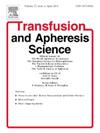Alloanti-D induction in a rare RhD variant (DBT-2) case: Insights from serological and molecular biological testing
IF 1.4
4区 医学
Q4 HEMATOLOGY
引用次数: 0
Abstract
Background
The RhD antigen is the most immunogenic within the Rh blood group system, playing a pivotal role in clinic. The D variant phenotype is a rare occurrence, characterized by low expression of the D antigen or partial deletion of the RhD antigen on the surface of red blood cells (RBCs). For individuals with the D variant, transfusion with RhD-negative blood is crucial for ensuring transfusion safety.
Case presentation
We present a case of a 63-year-old Han Chinese female, identified as a D variant phenotype without a history of blood transfusion but with a history of pregnancy. Pre-transfusion testing revealed the presence of alloanti-D antibodies. Genetic analysis confirmed the patient's genotype as RHD-CE (5−9)-D, and her phenotype was classified as DBT-2.
Conclusion
This report marks the first case in China of anti-D alloimmunization in patients with the D variant. Both serological and molecular detection of the D variant are essential to ensure the safety of blood transfusions.
罕见RhD变异(DBT-2)病例的同种异体抗- d诱导:来自血清学和分子生物学测试的见解
RhD抗原是Rh血型系统中最具免疫原性的抗原,在临床中起着举足轻重的作用。D变异表型是一种罕见的现象,其特征是红细胞(rbc)表面的D抗原低表达或RhD抗原部分缺失。对于携带D型变异的个体,输注rhd阴性血液对于确保输血安全至关重要。病例介绍:我们报告一例63岁汉族女性,确诊为D变异表型,无输血史,但有妊娠史。输血前检测显示存在同种异体抗d抗体。遗传分析证实患者基因型为RHD-CE(5−9)-D,表型为DBT-2。结论本报告为国内首次对D变异患者进行抗D异体免疫。D型血的血清学和分子检测对于确保输血安全至关重要。
本文章由计算机程序翻译,如有差异,请以英文原文为准。
求助全文
约1分钟内获得全文
求助全文
来源期刊
CiteScore
3.60
自引率
5.30%
发文量
181
审稿时长
42 days
期刊介绍:
Transfusion and Apheresis Science brings comprehensive and up-to-date information to physicians and health care professionals involved in the rapidly changing fields of transfusion medicine, hemostasis and apheresis. The journal presents original articles relating to scientific and clinical studies in the areas of immunohematology, transfusion practice, bleeding and thrombotic disorders and both therapeutic and donor apheresis including hematopoietic stem cells. Topics covered include the collection and processing of blood, compatibility testing and guidelines for the use of blood products, as well as screening for and transmission of blood-borne diseases. All areas of apheresis - therapeutic and collection - are also addressed. We would like to specifically encourage allied health professionals in this area to submit manuscripts that relate to improved patient and donor care, technical aspects and educational issues.
Transfusion and Apheresis Science features a "Theme" section which includes, in each issue, a group of papers designed to review a specific topic of current importance in transfusion and hemostasis for the discussion of topical issues specific to apheresis and focuses on the operators'' viewpoint. Another section is "What''s Happening" which provides informal reporting of activities in the field. In addition, brief case reports and Letters to the Editor, as well as reviews of meetings and events of general interest, and a listing of recent patents make the journal a complete source of information for practitioners of transfusion, hemostasis and apheresis science. Immediate dissemination of important information is ensured by the commitment of Transfusion and Apheresis Science to rapid publication of both symposia and submitted papers.

 求助内容:
求助内容: 应助结果提醒方式:
应助结果提醒方式:


